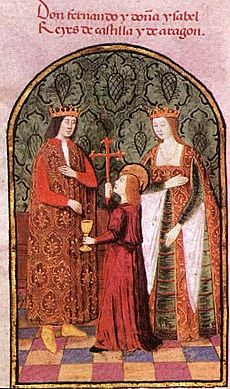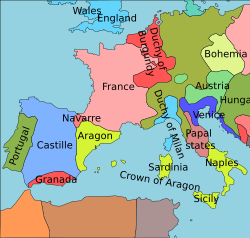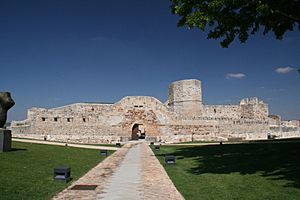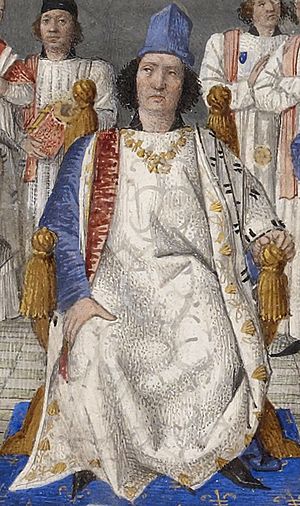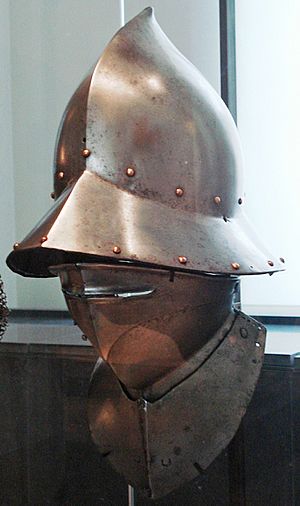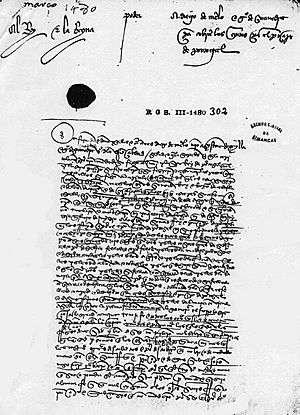War of the Castilian Succession facts for kids
Quick facts for kids War of the Castilian Succession |
|||||||
|---|---|---|---|---|---|---|---|
 The two main people who wanted to be Queen: Isabella I of Castile and Joanna la Beltraneja |
|||||||
|
|||||||
| Belligerents | |||||||
|
|
||||||
| Commanders and leaders | |||||||
|
|
||||||
The War of the Castilian Succession was a fight that happened from 1475 to 1479. It was about who would become the ruler of the Crown of Castile. The main people involved were Joanna, who was thought to be the daughter of the previous king, and Isabella, the king's half-sister. Isabella eventually won the war.
This war was not just a local fight; other countries got involved. Isabella was married to Ferdinand, who was going to be the king of Crown of Aragon. Joanna married King Afonso V of Portugal, who was her uncle. France also helped Portugal because they were rivals with Aragon over land in Italy and Roussillon.
At first, Joanna's side had some wins. But King Afonso V of Portugal was not very aggressive in his attacks. A battle called the Battle of Toro in 1476 ended without a clear winner. This caused Joanna's supporters to start leaving her side. Isabella was then recognized as the Queen in the Courts of Madrigal-Segovia.
The war then continued mainly between Castile and Portugal. A big part of this later stage was fighting at sea in the Atlantic Ocean. Both sides wanted control over the rich trade routes to Guinea, which had gold and slaves. In 1478, the Portuguese navy won an important sea battle called the Battle of Guinea.
The war ended in 1479 with a peace agreement called the Treaty of Alcáçovas. This treaty said that Isabella and Ferdinand were the rightful rulers of Castile. It also gave Portugal control over most of the Atlantic Ocean, except for the Canary Islands. Joanna lost her claim to the throne and stayed in Portugal for the rest of her life.
This conflict has a few other names. Some call it the Second Castilian Civil War, but this can be confusing. Others call it the War of Portugal, but this name only shows Castile's point of view. Sometimes it's called the War of 1475–1479 to be more neutral.
Contents
Why the War Started: Who Would Be Queen?
Who Would Rule Castile?
Joanna was born in 1462. She was the only child of King Henry IV of Castile. At first, she was named the next in line to the throne. But a rumor spread that she was not King Henry's daughter. People said her father was actually Beltrán de la Cueva. Because of this rumor, Joanna was mockingly called "la Beltraneja."
In 1464, powerful nobles forced King Henry to take away Joanna's title. They named his half-brother, Alfonso, as the next heir. In 1465, some nobles even removed King Henry from power and put Alfonso in charge. This led to a small war. It ended in 1468 when Alfonso, who was only 14, died.
King Henry IV became king again. But the question of who would rule next was still there. It was between Joanna, his daughter, and Isabella, his half-sister. They tried to solve this with the Treaty of the Bulls of Guisando. This treaty gave Isabella the right to be queen, but it limited who she could marry.
However, Isabella secretly married Ferdinand in 1469 when she was 17. She did this even though King Henry IV did not want her to. More and more people started to support Isabella and Ferdinand. In 1472, they even got approval for their marriage from Pope Sixtus IV. By 1473, the strong Mendoza family also supported them.
When King Henry IV died in December 1474, both Joanna and Isabella were declared Queen by their supporters. Joanna's side knew they were weaker than Isabella's. So, they suggested that the 43-year-old King Afonso V of Portugal marry Joanna. Afonso was Joanna's uncle and had been a widower for about 20 years. They hoped he would become King of Castile with her.
Who Supported Whom: International Alliances
The Kingdom of France and the Crown of Aragon had been rivals for a long time. They fought over control of Roussillon and later over power in Italy. In June 1474, French troops invaded Roussillon, and Aragon had to retreat.
Since Ferdinand, who was married to Isabella, was going to be the king of Aragon, France got involved. In September 1475, Louis XI of France officially supported Joanna and Afonso. France was also fighting the Duchy of Burgundy at the same time. This made Burgundy a potential ally for Isabella, but they mostly focused on their own war with France.
The Kingdom of England also briefly fought France. King Edward IV landed in Calais in June 1475. But Louis XI quickly made peace with Edward. They signed the Treaty of Picquigny in August. Edward IV agreed to a nine-year break from fighting in exchange for money and went back to England.
The Kingdom of Navarre was having its own civil war. The Muslim Kingdom of Granada stayed neutral, even though Portugal tried to get them to join the war.
Castile and Portugal: Fighting Over the Atlantic Ocean
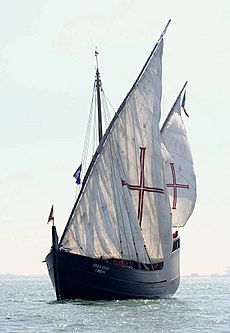
For many years, sailors and traders from Portugal and Castile explored the Atlantic Ocean. Owning the Canary Islands was a big disagreement between the two kingdoms. Later, controlling trade with Guinea and Elmina became even more important. These areas were rich in gold and slaves.
In the first half of the 1400s, Castile took over some of the Canary Islands. They did this through agreements with knights and nobles. Portugal did not agree with Castile's claim to the islands. Portugal kept exploring Guinea and made a lot of money from trade there.
Starting in 1452, Pope Nicholas V and Callixtus III changed the Holy See's policy. They issued special orders called bulls that favored Portugal. These orders gave Portugal control over trade and religious matters in Guinea and lands "further beyond." The Pope did not decide who owned the Canary Islands. The King of Portugal allowed foreign traders to do business on the African coasts if they paid taxes.
In August 1475, after the war began, Isabella said that parts of Africa and Guinea belonged to Castile. She encouraged Castilian merchants to sail there. This started a naval war in the Atlantic.
The War Begins: Key Events
Who Fought on Each Side in 1475?
- For Joanna:
- Portugal
- France
- Some powerful Castilian nobles, like the Archbishop of Toledo (Alfonso Carrillo de Acuña). Also, families with land near Portugal, like the Estúñiga family, the Marquis of Villena (Diego López Pacheco), the Marquis of Cádiz (Rodrigo Ponce de León), and the leader of the Order of Calatrava (Rodrigo Téllez Girón).
- For Isabella:
- The Crown of Aragon
- Most of the other Castilian nobles, including the strong Mendoza family and the Manrique de Lara family. Also, the Duke of Medina Sidonia (Enrique Pérez de Guzmán), Beltrán de la Cueva, the Order of Santiago, and most of the Order of Calatrava.
The Duchy of Burgundy and England were fighting France in 1475. But they did not work together with Isabella's side. So, they are usually not seen as part of Isabella's alliance.
Fighting for the Throne (May 1475 – September 1476)
Afonso V Enters Castile
A Portuguese army led by Afonso V entered Castile on May 10, 1475. They went to Plasencia, where Joanna was waiting. On May 25, Joanna and Afonso were declared rulers of Castile and got married. The Pope's permission for their marriage (since Joanna was Afonso's niece) arrived a few months later.
From Plasencia, they marched to Arévalo. Afonso hoped to meet up with French troops there. The castles of Burgos, Plasencia, and Arévalo were controlled by Joanna's supporters. But the city of Burgos itself supported Isabella.
Afonso found fewer supporters in Castile than he expected. So, he changed his plan. He decided to focus on controlling the area closest to Portugal, especially Toro. Toro welcomed him, but the castle there stayed loyal to Isabella. Zamora and other towns in the León also accepted him.
In La Mancha, Rodrigo Tellez-Giron, a leader of the Order of Calatrava and a supporter of Joanna, captured Ciudad Real. But Rodrigo Manrique, another leader of the same Order and the leader of the Order of Santiago, took the city back for Isabella.
Ferdinand gathered an army in Tordesillas. On July 15, he ordered them to march and find Afonso. Four days later, they reached Toro. The King of Portugal avoided a direct fight. Ferdinand did not have enough supplies for a long siege. So, he had to go back to Tordesillas and send his army home. The castle of Toro surrendered to Afonso V. Afonso then returned to Arévalo to wait for the French to arrive.
Rodrigo Alfonso Pimentel, a supporter of Isabella, stayed with a small group in Baltanás to watch the Portuguese. On November 18, 1475, he was attacked, defeated, and captured. This win opened the way to Burgos for Afonso V. But Afonso decided to retreat again, this time to Zamora. His lack of strong action weakened Joanna's support in Castile, and her alliance started to fall apart.
Isabella's Counterattack
Isabella's supporters fought back. They took Trujillo and gained control of lands belonging to the Order of Alcántara, much of the Order of Calatrava, and the Marquisate of Villena. On December 4, some of the soldiers in Zamora rebelled against King Afonso. He had to flee to Toro. The Portuguese soldiers kept control of the castle, but the city welcomed Prince Ferdinand the next day.
In January 1476, the castle of Burgos surrendered to Isabella. They made a deal that no one who had fought against her would be punished.
The Battle of Toro
In February 1476, the Portuguese army, now stronger with troops brought by John II of Portugal, Afonso V's son, left Toro. They surrounded Ferdinand in Zamora. The siege was harder on the Portuguese because of the cold Castilian winter. On March 1, Afonso V started to go back to Toro. Ferdinand and his troops chased them. They caught up about 5 kilometers from Toro, and a battle began.
The fighting lasted three hours and was stopped by rain and night. The King of Portugal went back to Castronuño with some of his troops. His son, John, stayed near Toro. He led his army back to the city in an organized way and even captured some enemy soldiers.
Both sides said they won the battle. But politically, it was a big win for Isabella. Most of the Portuguese troops, along with Joanna, went back to Portugal. Joanna's side now had very few soldiers left in Castile.
War at Sea: Fighting for Trade Routes
One of Isabella and Ferdinand's goals was to challenge Portugal's control over the rich Atlantic lands of Guinea. The gold and slaves from there were a big source of money to pay for the war. So, sending ships to Guinea became very important for both sides.
Since the war started, Portuguese ships had been sailing along the coast of Andalusia. They captured fishing and merchant ships. To stop this, Isabella and Ferdinand sent four galleys led by Álvaro de la Nava. He stopped the Portuguese attacks and raided the Portuguese city of Alcoutim on the Guadiana River.
Sailors from Palos de la Frontera also raided the coasts of Guinea. A writer for Isabella, Alfonso de Palencia, wrote about a trip where two ships from Palos captured 120 Africans and sold them as slaves. Even though the rulers protested, another group of three ships soon captured an African king and 140 nobles from his village.
In May 1476, Isabella ordered the "King of Guinea" and his group to be freed. Her order was only partly followed. The king was freed and sent back to Guinea, but his companions were all sold as slaves.
In 1476, a Portuguese fleet of twenty ships, led by Fernão Gomes, sailed to Guinea to try and get back control there. The King of Castile ordered a fleet to be prepared to capture the Portuguese ships. He appointed Carlos de Valera to lead it. Valera had many problems getting the ships ready. Powerful nobles like the Marquis of Cadiz, the Duke of Medina Sidonia, and the Estuñiga family opposed him.
The preparations were also delayed by a sea battle. The Castilians found out that one or two Portuguese ships with valuable goods were leaving the Mediterranean to go back to Portugal. They were being protected by a pirate named Alvar Méndez. A fleet of five galleys and five caravels, led by Carlos de Valera and Andrés Sonier, attacked them near Sanlúcar de Barrameda. After a tough fight, the Castilians won.
Valera gathered a fleet of three ships from the Basque region and nine caravels from Andalusia. All were heavily armed. Since they could no longer catch the Portuguese fleet, Valera decided to sail towards the island of António Noli in the Cape Verde islands, near Guinea. They raided the island and captured António Noli, who ruled the area for the King of Portugal.
Next, they sailed to the coast of Africa. There, they captured two ships belonging to the Marquis of Cadiz that were carrying 500 slaves. The sailors from Palos then left the expedition. They were the most skilled in sailing to Guinea, so Valera returned to Andalusia.
This trip did not make much money. Most of the slaves were returned to the Marquis of Cadiz. Valera also had to pay the Duke of Medina Sidonia for damage caused on Noli Island, which the Duke claimed was his.
France Gets Involved
On September 23, 1475, King Louis XI of France signed a treaty to be allies with Afonso V of Portugal.
Between March and June 1476, French troops tried to cross the border at Fuenterrabía. But they were pushed back. Ferdinand used this chance to make his position stronger in the Kingdom of Navarre, which was not stable. In August, talks began in Tudela. This led to an agreement that ended the civil war in Navarre. Ferdinand gained control of Viana, Puente La Reina, and other strongholds. He also got the right to keep 150 soldiers in Pamplona.
This made Castile militarily stronger against any possible French attacks into Navarre.
In August 1476, Afonso V of Portugal left for France. He had signed a truce with Isabella and Ferdinand. In France, he tried to convince Louis XI to get more involved in the war. But Louis refused. He was focused on defeating his main enemy, Charles the Bold, the Duke of Burgundy.
Battle of Cabo São Vicente
The King of France sent a fleet led by the pirate Guillaume Coullon to help Portugal. In August 1476, King Afonso sent two Portuguese galleys full of soldiers along with Coullon's 11 ships to help the castle of Ceuta. On August 7, this fleet met five armed merchant ships from Cadiz that were going to England. These included three large Genoese ships, a galley, and a Flemish ship. Coullon tried to trick the merchants into being captured, but it failed. He was forced to fight.
The French-Portuguese side won. But because the French used fire weapons, two Genoese ships, the Flemish ship, two Portuguese galleys, and two of Coullon's ships caught fire. According to Palencia, about 2,500 French and Portuguese soldiers died.
Isabella and Ferdinand Take Control (September 1476 – January 1479)
After their important victory at the Battle of Toro, pushing back the French, and the truce with Afonso V, Isabella and Ferdinand were in a strong position to win the throne of Castile. Nobles who had supported Joanna had to accept this. They slowly started to pledge their loyalty to Isabella and Ferdinand. The war became smaller, with only small fights along the Portuguese border and continued sea battles for control of Atlantic trade.
Joanna's Supporters Join Isabella and Ferdinand
Throughout 1476, nobles who had supported Joanna started to join Isabella and Ferdinand. This included important figures like Juan Téllez-Girón and his brother Rodrigo, Luis de Portocarrero, and in September, the Marquis of Villena.
In November 1476, Isabella's troops captured the castle of Toro. In the next few months, they took control of the last border towns held by the Portuguese. They also dealt with their enemies in Extremadura.
In July 1477, Isabella arrived in Seville, the largest city in Castile. Her goal was to show her power over the nobles in Andalusia.
In April 1476, Isabella and Ferdinand first forgave the Marquis of Cadiz. He had been gaining power while his rival, the Duke of Medina Sidonia, who was Isabella's main supporter in Andalusia, had lost favor. Isabella skillfully negotiated and took control of the main strongholds in Seville that were held by the Marquis and the Duke. Instead of giving them back to their owners, she put new people in charge.
She also stopped both nobles from entering Seville. She said their presence at the same time would cause violent conflicts. This way, the Duke's political power over Seville disappeared, and the city came under the Crown's control.
One of the few nobles who refused to surrender was Marshall Fernán Arias de Saavedra. Isabella's troops surrounded his fortress at Utrera. They captured it by force in March 1478. Those who were defeated faced harsh punishment.
The first son of Isabella and Ferdinand, John of Aragon and Castile, was born in Seville on June 30, 1478. This brought new hope for the future of Isabella's rule.
Afonso V Returns
After his diplomatic failure in France, Afonso V decided to go back to Portugal. When he arrived in October 1477, he found that his son John had declared himself king. However, John was happy to see his father return and immediately gave the Crown back to him.
Trips to Guinea and Canary Islands in 1478
In 1477, a fleet of ships left Andalusia heading for Guinea.
At the start of 1478, Isabella and Ferdinand prepared two new expeditions from the port of Sanlúcar de Barrameda. One was going to Elmina. The other, with at least 35 ships, aimed to conquer the island of Gran Canaria.
Prince John of Portugal knew about Castile's plans. He prepared a fleet to surprise his enemies in the Canary Islands. The Castilian fleet at Gran Canaria was still unloading its soldiers when news arrived that a Portuguese fleet was coming. The Castilian fleet immediately sailed away, leaving 300 Castilian soldiers behind. These soldiers managed to stop the Portuguese from landing. But this small group was not enough to conquer the island. They stayed inactive until more Castilian soldiers arrived the next year.
The other Castilian fleet reached Elmina and got a lot of gold. The fleet stayed there for a few months, following orders from the Crown's trade representative. Then the Portuguese fleet arrived and attacked the Castilians. The Castilians were defeated and taken as prisoners to Lisbon. According to Hernando del Pulgar, the gold King Afonso captured allowed him to restart the war on land against Castile. Portuguese sources say that both the prisoners and a lot of the captured gold were returned to Castile after the peace treaty in 1479.
Peace Between Castile and France
Towards the end of 1478, before news of the defeat at Elmina reached Castile, King Louis XI of France offered a peace treaty to Isabella and Ferdinand. It was signed in Guadalupe and included these points:
- Louis XI recognized Isabella and Ferdinand as the rulers of Castile and León.
- Ferdinand agreed to end his alliance with Maximilian I, the Duke of Burgundy.
- Both sides agreed to let someone else decide on matters related to Roussillon.
Final Stages of the War (January – September 1479)
Towards the end of 1478, some of Joanna's supporters rebelled in Extremadura, La Mancha (led by the Marquis of Villena), and Galicia. The Portuguese, stronger after their naval victory in Guinea, again sent troops into Castile to help their allies.
Portuguese Attack
In February 1479, a Portuguese army led by Garcia de Meneses, the Bishop of Évora, entered Extremadura. Their goal was to take and strengthen the strongholds of Mérida and Medellín. These were controlled by Beatriz Pacheco, a supporter of Afonso V. According to Palencia, the Portuguese army had about 1,000 knights (250 of whom were Castilian) and foot soldiers. 180 knights from the Order of Santiago marched with them, led by Alfonso de Monroy.
On February 24, near the hill of Albuera, Isabella's forces challenged the army. They were led by Alonso de Cárdenas, the Master of the Order of Santiago. His army had 500 knights from the Order, 400 knights from the Hermandad (mostly from Seville), and 100 foot soldiers. The battle was very tough. Isabella's foot soldiers were hit hard by the cavalry of Joanna's side and became disorganized. But the Master of Santiago helped the panicked soldiers. The Portuguese had to retreat, leaving behind many valuable items and about 85 dead knights. Only 15 of Isabella's knights were killed.
Most of the Portuguese army managed to find safety in Mérida. From there, they continued to Medellín, which they occupied. King Ferdinand's supporters then surrounded Medellín and Mérida.
The Pope Changes Sides
A messenger named Jacobo Rondón de Seseña arrived in Castile. He brought news that Pope Sixtus IV had changed his mind. The Pope had cancelled the special permission he had given Afonso V to marry his niece Joanna. This greatly weakened Joanna's claim to the throne and the King of Portugal's right to rule Castile.
Last Castilian Efforts at Sea
In February 1479, Isabella and Ferdinand tried to gather a new fleet of about twenty caravels. They wanted to drive the Portuguese out of Elmina. However, they could not get enough ships. After this, no major expeditions were launched until the peace agreement with Portugal.
Peace Talks Begin
In April 1479, King Ferdinand arrived at Alcántara for peace talks. These talks were organized by Beatrice, who was Afonso V's daughter and Isabella of Castile's aunt. The negotiations lasted 50 days, but they could not reach an agreement.
The two sides kept fighting, trying to improve their positions before new peace talks. Isabella and Ferdinand launched an attack against Alfonso Carrillo de Acuña, the Archbishop of Toledo. He was forced to surrender. This allowed the rulers to challenge the Marquis of Villena. Meanwhile, the Portuguese soldiers in Extremadura successfully held off a Castilian siege.
Peace talks started again in the summer, and this time an agreement was reached.
The Peace Treaty
The treaty that ended the war was signed in the Portuguese city of Alcáçovas on September 4, 1479. The King of Portugal approved the agreement on September 8, 1479. Isabella and Ferdinand, the rulers of Castile and Aragon, approved it in Toledo on March 6, 1480. It is also known as the Treaty of Alcáçovas-Toledo.
In this treaty, Afonso V gave up his claim to the throne of Castile. Isabella and Ferdinand gave up any claim to the Portuguese throne. The two kingdoms divided their areas of influence in the Atlantic Ocean. Portugal gained control of most of the territories, except for the Canary Islands. (The islands of Gran Canaria, La Palma, and Tenerife still needed to be conquered by Castile).
Joanna la Beltraneja gave up all her Castilian titles. She was given two choices: either marry Prince John, the son of Isabella and Ferdinand, or go to a convent. Joanna chose to go to a convent, but she remained involved in politics until she died.
Isabella, Princess of Asturias (1470–1498), the daughter of Isabella and Ferdinand, married Afonso, Prince of Portugal, who was the heir to the Portuguese throne. Isabella and Ferdinand paid a large dowry for their daughter. This money was like a payment for the war that Portugal had won.
See also
 In Spanish: Guerra de sucesión castellana para niños
In Spanish: Guerra de sucesión castellana para niños


